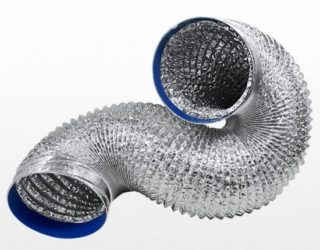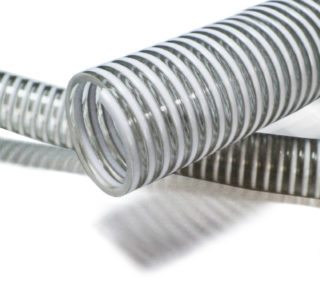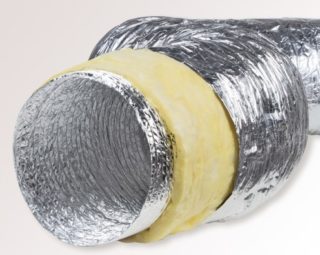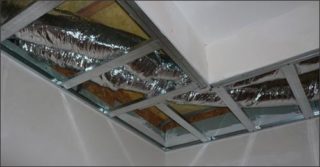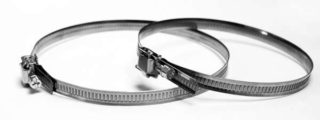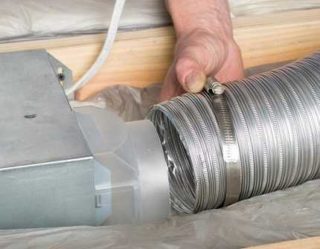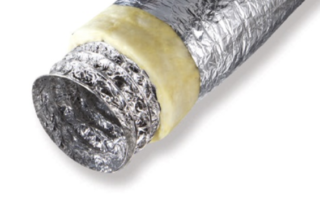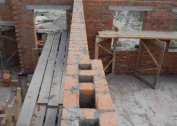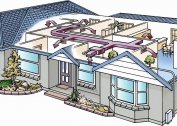For the installation of ventilation systems, a flexible duct is often used. The element has the appearance of a corrugated sleeve, which can be bent at different angles. The duct has an internal rigid frame made of a special steel wire of increased stiffness. An element may have multilayer walls for the purpose of heat, noise, and sound insulation.
What and how flexible ducts are made of
Corrugated hose for ventilation is made of aluminum foil, polyvinyl chloride (PVC), polyester compounds, polyolefin film, stainless steel or solid sheets of foil.
The manufacturing process of ventilation elements looks something like this:
- The hard wire curved in a spiral is glued on both sides with aluminum or foil tapes.
- The outer material is glued together in a spiral. As the adhesive composition, acrylic adhesive with special fireproof non-combustible impurities is used.
- Depending on the type of corrugated sleeve produced, the layers of the outer tape can be from 2 to 6.
Frameless flexible ducts have been launched into widespread production. They are made from soft PVC or solid aluminum sheets. Such elements are easily bent at any angle, convenient to use, have low weight. The cost of frameless sleeves is an order of magnitude lower.
Specifications
Flexible corrugation for ventilation is selected according to technical characteristics.
- Production material (aluminum, PVC, polyester).
- The working temperature of refractory and heat-resistant hoses is from -30 to +140 degrees.
- Internal diameter - from 100 mm and more.
- The length in the compressed and extended state is from 1.5 m and above.
- The thickness of the wire frame - from 0.8 to 1.7 mm.
- The coefficient of resistance to friction is 0.02-0.05. The lower it is, the lower the noise level during transportation of air masses.
- Air flow rate - from 20 m / s.
With the help of a corrugated sleeve for ventilation, you can arrange the system in limited spaces or place it under a suspended, stretch ceiling.
Types of Flexible Ducts
Corrugated duct is available in several forms:
- No thermal insulation. Non-insulated sleeves are made of aluminum foil with the addition of polyester. More often, such elements are used for mounting ventilation systems in hidden areas of the room or for connecting the main line with ventilation grilles.
- Equipped with thermal insulation. Such sleeves are mandatory for those rooms in which there is no heating. Otherwise, condensation will form in the line, which will sooner or later put the whole system out of order. Insulation is placed between two layers of aluminum foil or PVC. It is difficult to independently establish such elements without damaging them.
- Heat and sound insulating. In this case, the corrugated sleeve is designed in such a way that does not allow condensate to be present in the line and at the same time reduces the coefficient of resistance to air friction inside. More often isolated types of sleeves have several layers of material. The diameter of the elements varies from 10 cm to 35 cm and sometimes higher. Spiral pitch - from 25 cm.
- Silencers Sleeves have a bilateral covering from PVC. Due to this, they have minimal resistance to the flow of air masses, therefore they are distinguished by a low noise level in operation.
Flexible plastic ducts for ventilation are not inclined to accumulate static electricity charges. But this does not eliminate the need to ground the entire ventilation system.
Where is the product used?
The use of flexible ventilation ducts is noted in such conditions:
- installation of air conditioning systems in residential and commercial premises;
- at chemical enterprises;
- in the food industry;
- in pharmaceutical plants;
- in the oil refining industry, etc.
Such elements allow even smoke and other contaminated air masses to be transported without harm to their internal walls.
Rules and recommendations for installation
To mount a flexible ventilation duct for all the rules, you must adhere to the following recommendations:
- In rooms with temperature differences or in unheated buildings, only insulated air ducts must be installed. For these purposes, it is better to call a professional, since the sleeve has an impressive weight and requires careful handling.
- When installing a heat-insulating corrugated sleeve, the joints between the elements must be glued with a special tape. It helps to additionally retain heat and reduce noise during transportation of air masses.
- Flexible ducts must be stretched to the maximum length before starting work. Such their position reduces the air resistance during the movement of air in the pipes and reduces the noise level.
- To maintain pressure in the line, it is necessary to make a maximum turning radius. It must be at least two pipe diameters.
- A combination of corrugated PVC pipes with steel or aluminum structures is allowed.
- The highway is located taking into account the direction of the spiral coil in the frame. To do this, you need to focus on the direction of the swirling flow of air masses that the hood is transporting. Often the direction of the location of the spiral turn is indicated on the package with the corrugated element.
- For vertical sections of the line, rigid steel elements are used.
- The maximum temperature load on flexible ducts must be taken into account when choosing them.
- In no case should you arrange ventilation corrugated sleeves in the ground.
- To seal all joints, special flexible inserts are used.
- Between adjacent fasteners, bending or sagging of more than 5 mm is not allowed.
- The flexible ventilation duct must not come into contact with heating elements.
A competent approach to the organization of the ventilation system will save you from unforeseen expenses associated with the repair or replacement of equipment.
Tools and materials
For a flexible ventilation device, it is necessary to prepare the following materials and tools:
- roulette;
- marker;
- nippers;
- pliers;
- knife;
- screwdriver;
- safety glasses and gloves;
- hose clamps;
- mounting tape.
For independent work, it is recommended to use the help of a friend or neighbor. Together, it is easier to lift and fasten flexible ducts.
Work Stages
To independently install a small area of the ventilation system, you must do the following:
- Measure the distance from the exhaust outlet to the final point of the ventilation system, which will be interconnected via a sleeve.
- Choose a flexible plastic duct or aluminum sleeve of the right size. The diameters of the outlet and the flexible duct must match.
- Connect one end of the sleeve to the cooker hood in the kitchen and secure with a hose clamp.
- Stretch the corrugation as far as possible from the attachment point to the hood towards the outlet. Make bends of the recommended radius so as not to disturb the pressure in the system.
- With a large length of the line, secure the sleeve with clamps with rubber gaskets in increments of 1–1.5 m. The diameter of the clamp should coincide with the cross section of the sleeve. Otherwise, the clamped sleeve will not work correctly.
The passage of a flexible metallized or PVC element through the wall is carried out only with the use of a rigid sleeve. The same applies to insulated corrugation for ventilation. All joints must be sealed.
Sagging pipe is possible no more than 5 cm per meter of length of the line.
Limitations on the use of a flexible duct
No matter how convenient the flexible sleeve is in installation, it can not always be used. The following conditions and situations are prohibited:
- vertical highways with a height difference of 6 m (above 2 floors);
- ventilation systems with a temperature of incoming air masses from +120 degrees;
- systems and pipelines with excess heat in their individual sections;
- ventilation lines in the open air (except when the reinforced corrugated sleeve is protected from atmospheric precipitation and solar radiation);
- laying the line through walls and floors where the use of a smoke exhaust valve or automatic fire damper is necessary;
- laying a line through the walls of buildings that have a fire rating of more than 1 hour;
- direct contact of a metal or PVC element with aggressive media or abrasives.
In addition, the device of flexible ventilation in kitchen industrial premises, in ironing rooms, laundries, is prohibited, unless otherwise indicated by the manufacturer.
Popular manufacturers
The most popular on the market are air ducts of such manufacturers:
- ALUDUCT. The brand produces products that can be operated at temperatures in the system from -30 degrees to +140 degrees. Maximum working pressure up to 2,500 Pa. And the speed of air masses is 30 m / s.
- VENTPROFIL. Russian-made products. The average price is from 430 rubles for a 10-meter sleeve with a section of 102 mm for uninsulated material. The working temperature of the ducts is from -30 to +100 degrees. Maximum working pressure up to 2500 PA.
- Dec. Russian manufacturer of products. The main feature of Dec ducts is that they can be used in systems with a high content of aggressive substances.
- Diaflex Russian-made products. The company offers sleeves of the Economy, Classic and Premium series in all types of ducts - non-insulated, insulated, sound and sound absorbing.
- AIRONE Another major Russian manufacturer of elements for ventilation systems. Products are of high quality, optimal technical characteristics. The working temperature of the elements is from - 30 to +100 degrees.
When choosing a flexible sleeve for your home for a ventilation system, be sure to take measurements of the diameters of the inlet and outlet openings of the hood.
